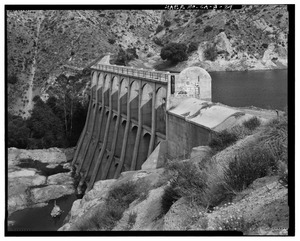Little Rock Dam facts for kids
Quick facts for kids Little Rock Dam or Littlerock Dam |
|
|---|---|

West end of dam, looking southeast
|
|
|
Location of the dam in California
|
|
| Official name | Little Rock-Palmdale Dam |
| Location | California, United States |
| Coordinates | 34°29′09″N 118°01′19″W / 34.48583°N 118.02194°W |
| Opening date | 1924 |
| Owner(s) | Palmdale Water District Littlerock Creek Irrigation District |
| Dam and spillways | |
| Type of dam | Concrete gravity |
| Impounds | Little Rock Creek |
| Height | 124 ft (38 m) |
| Length | 576 ft (176 m) |
| Reservoir | |
| Creates | Little Rock Reservoir |
| Total capacity | 3,700 acre⋅ft (4,600,000 m3) |
| Catchment area | 63.7 sq mi (165 km2) |
The Little Rock Dam, also known as Littlerock Dam, is a concrete dam in Los Angeles County, California. It is located about 5 miles (8 km) south of Palmdale. The dam holds back water from Little Rock Creek.
The Palmdale Water District and Littlerock Creek Irrigation District own the dam and the reservoir it creates. They use the water for farms and for people living in the area. The dam also helps control floods.
The dam stands 124 feet (38 m) tall from its base to the top. It stretches 576 feet (176 m) across the canyon. The reservoir behind the dam can hold 3,700 acre-feet (4.6 million m³) of water. This is a lot of water! The reservoir gets its water from a large area of 63.7 square miles (165 km²) on the north side of the San Gabriel Mountains.
Contents
Building the Little Rock Dam
Who Designed the Dam?
A famous engineer named John S. Eastwood designed the Littlerock Dam. He was known for designing several dams in the western United States. The Palmdale Irrigation District, which is now the Palmdale Water District, built the dam in 1924. Its main purpose was to supply water to fruit orchards in the area.
A Record-Breaking Design
When it was first built, the dam was 112 feet (34 m) tall. It could hold 2,400 acre-feet (3.0 million m³) of water. At that time, it was the tallest multiple-arch reinforced concrete dam in the world. This special design, along with its record height, caused a lot of discussion.
Changes and Upgrades to the Dam
Early Renovations and Challenges
Because of the dam's unique design, the state government required changes in 1932. Concrete supports, called buttresses, were added to the front of the dam. In 1938, the dam almost broke during a huge flood in Los Angeles. This flood caused hundreds of people in nearby towns to be evacuated.
The dam was updated again in 1966. These changes were made to meet new safety rules and because more people were moving into the area. In the 1970s, the dam was added to the National Register of Historic Places (NRHP). This list recognizes important historical sites.
Major Modern Upgrades
The last big renovation of the dam happened in 1994. Workers strengthened the dam's face with a material called roller-compacted concrete. This made the dam look like a typical gravity dam, hiding its original multiple-arch design. However, if the water level in the reservoir is low, you can still see the original arches on the back of the dam.
Because of these design changes, the dam was removed from the National Register of Historic Places. During this renovation, the dam was also made 12 feet (3.7 m) taller. A new spillway was added, which is a channel for water to flow over the dam. These changes increased the reservoir's capacity to its current 3,700 acre-feet (4.6 million m³).
Future Plans for the Dam
The dam and reservoir are set for a big renovation project in three parts.
- The first part involves building a special underground structure within Littlerock Reservoir.
- The second part is to remove a large amount of built-up dirt and sand from the reservoir. This will take about seven to twelve years.
- Finally, there will be ongoing removal of sediment each year to keep the reservoir at its full capacity.
There are no plans to open the dam or reservoir facilities to the public again.


